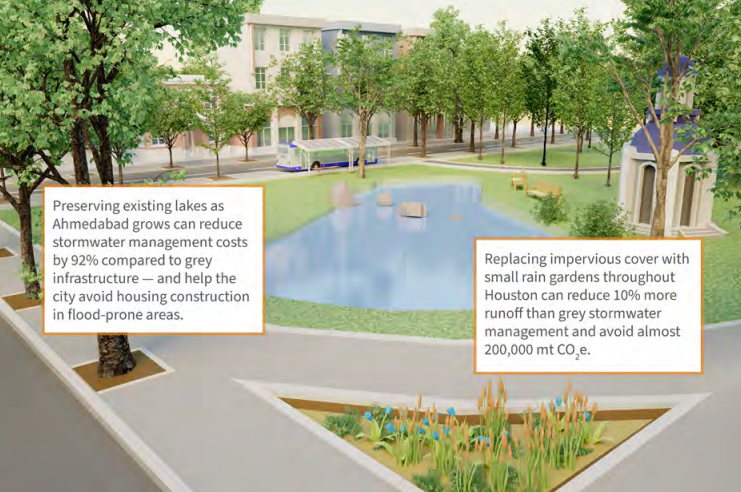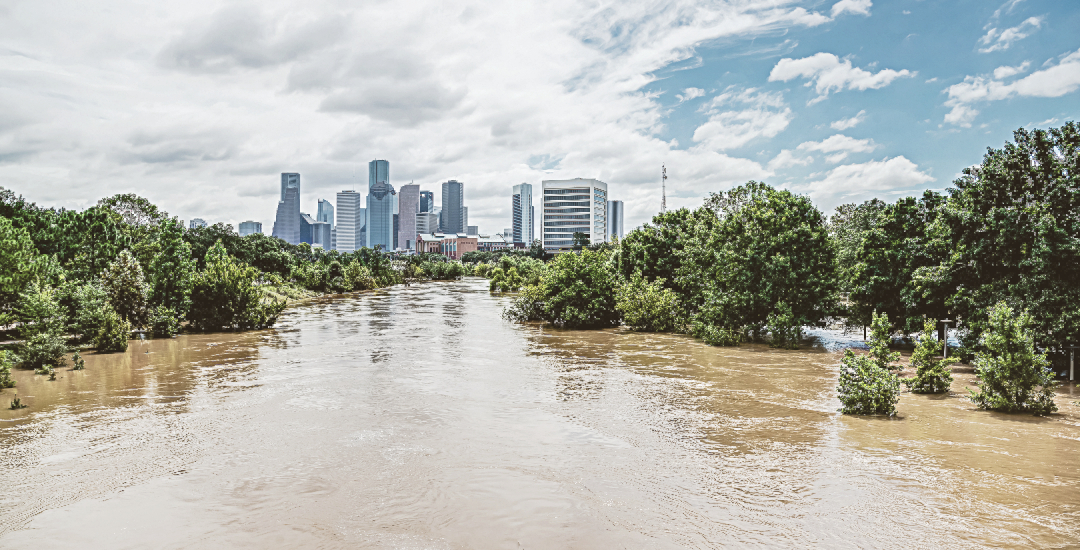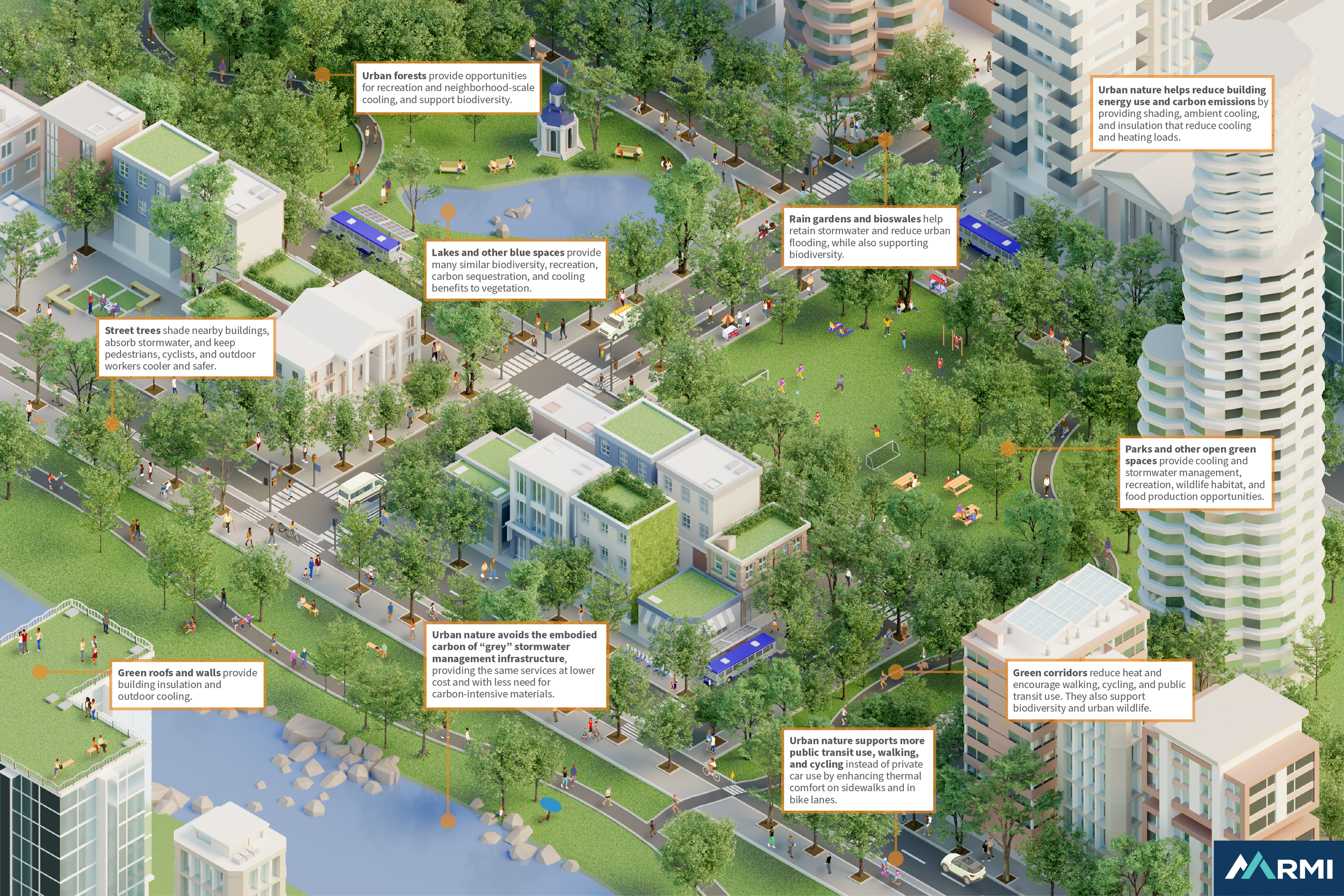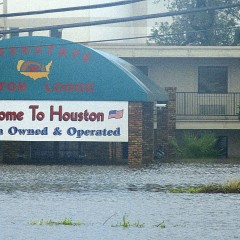The RMI analysis focused on six cities around the world to highlight the potential positive impacts of increased green stormwater infrastructure. The cities included three in the U.S. — Austin, Houston, and Sacramento, Calif. — and Abidjan, Côte d’Ivoire, Ahmedabad, India and Curitiba, Brazil.
“Green features alone cannot solve Houston’s flooding challenges when so many residents already live in flood-prone areas. But green and hybrid infrastructure could play an important, climate-friendly role in urban design that sites housing in areas with better flood protection and preserves or converts flood-prone areas into green and blue spaces,” the authors write in the report, “Growing to Its Potential: The Value of Urban Nature for Communities, Investors, and the Climate.”
Using the EPA’s Greenhouse Gas Equivalencies Calculator, RMI’s report suggested that if Houston were to convert its existing non-absorbent infrastructure into green infrastructure, it would avoid roughly 199,000 metric tons of carbon emissions through 2050. To isolate the same amount of carbon, it would take the planting of 3.3 million tree seedlings over 10 years. These measures would also have considerable cost savings — as much as $12 billion over 30 years — over traditional infrastructure investments.
The Urban Edge spoke with two of the report’s authors, Julia Meisel, a manager in urban transformation, and Zach Clayton, an associate in urban transformation, to discuss the report. The interview has been edited for length and clarity.
How would you describe urban nature and its benefits?
Meisel: When we talk about urban nature, we’re really talking about all of the vegetated spaces and water bodies in a city. Really anything green or blue — parks, urban forests, trees, lakes, wetlands or prairies. Sometimes it’s called nature-based solutions or green infrastructure. Houston talks a lot about green stormwater infrastructure. It’s all basically the same, we just try to use the term urban nature to capture everything that is in a city that fits the bill.
Urban nature provides a huge range of benefits. There’s heat mitigation — trees provide shade and water evaporates. There are also climate resilience benefits, like reducing flooding, and health benefits. There are direct economic benefits like job creation. These benefits accrue and are experienced by everyone within a city. But they are also very local in that urban nature can look different in different neighborhoods in terms of what is needed. Urban nature is a really effective climate mitigation tool. It can help local governments save energy, reduce carbon emissions and save money. At the same time, it can help cities meet the other goals they have — not just their climate goals, but also their resilience and equity goals. For cities with tight budgets, which is most cities, this is something that can help them meet multiple priorities cost effectively.
Courtesy Rocky Mountain Institute
The report contrasts traditional stormwater infrastructure such as concrete basins, pipes and detention ponds — known as "gray infrastructure"—with "blue" and "green" infrastructure alternatives. What advantages do these offer?
Meisel: Green infrastructure and blue infrastructure are two types of infrastructure designed to support and enhance natural systems. Green infrastructure refers to an interconnected network of natural areas and other green spaces, such as parks, gardens, forests, wetlands and green roofs. These features are designed to provide a range of environmental, social, and economic benefits, including improving air and water quality, mitigating urban heat islands, enhancing biodiversity, reducing stormwater runoff, and providing recreational opportunities. Blue infrastructure, on the other hand, refers to a network of water resources, such as rivers, lakes, wetlands, and coastlines, that are managed in a sustainable way to provide a range of benefits. Blue infrastructure projects can include measures to improve water quality, increase water storage capacity, reduce the risk of flooding and erosion, and enhance biodiversity. In some cases, green and blue infrastructure can overlap, such as in the case of constructed wetlands or rain gardens, which are designed to manage stormwater runoff while providing habitat for wildlife and improving the aesthetic value of urban spaces. Both types of infrastructure are increasingly seen as important components of sustainable development and resilience planning in urban areas.
Clayton: Green and blue infrastructure have been around for a while. What we’re hoping our analysis will do is push cities past thinking of these as pilot projects and as a real strategy to use in stormwater management. We’re making sure to push that beyond the next step. Houston is already making some impressive progress, but we’re hoping it can go beyond those pilot programs and get into other areas.
What challenges do cities face when integrating blue infrastructure or green infrastructure?
Meisel: One of the biggest issues is financing. That shows up in the local government context and in terms of external investment. Nature has all this value in cities, but it’s not receiving investment at a level that reflects that. Cities often have park departments pretty low on the list in terms of budget. A lot of that work is considered discretionary and it often gets cut. And I think that if there is a change in mindset viewing the sort of work as the critical infrastructure that it is and budget for that accordingly it would go a long way.
Clayton: I would also add that embodied carbon can be a bit of a jargon word, but it becomes really important in our analysis. Cities are trying to reduce their emissions, and one of the key ways to do that is through the entire emissions of all of the projects over the course of the city. Citizens are trying to see that these are creating benefits today, and not 10 years into the future. One of the great things about urban nature is the installation of a rain garden, pocket prairie or pocket wetland is not only reducing carbon emissions over the life cycle, you're capturing stormwater and you're providing an immediate amenity to the community as well. That's not something you get if you put in a concrete detention basin.

What lessons can Houston learn from other cities studied in the report?
Meisel: The easiest way to avoid excessive stormwater runoff is to avoid developing more impervious areas in the first place. Houston has challenges with a very flat slope, and a lot of impervious area. One of the things we learned from Ahmedabad, India was that the best way to get around having a lot of runoff is to preserve as much existing natural landscape in areas of new development as possible. In Houston we saw a city that’s already very developed. But as it continues to grow on the fringes, having more of a spongy, absorbent landscape preserved in that new development would be helpful.
Similarly, as redevelopment projects occur within the already built area of the city, that also provides opportunities to integrate whatever green spaces might still be left, and to add more of the green infrastructure elements from the start, so you don’t run into this impervious surface problem.



